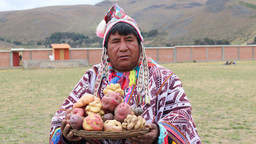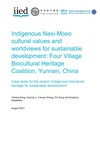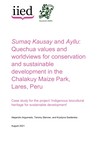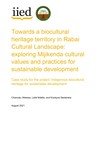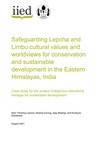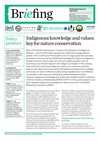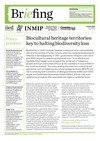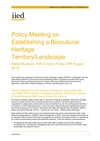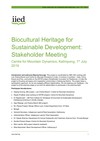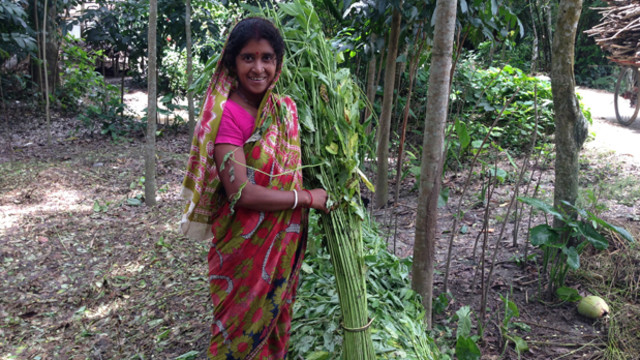Indigenous biocultural heritage for sustainable development
IIED worked with partners in China, India, Kenya and Peru to explore how the interlinked traditional knowledge, biodiversity, culture and landscapes – the biocultural heritage – of Indigenous Peoples can contribute to sustainable development. This research contributed directly to establishing new biocultural heritage territories through a process building on the successful Potato Park model.
Principal researcher and team leader (biocultural heritage), IIED's Natural Resources research group

The Potato Park Biocultural Heritage Territory near Pisaq in Peru is collectively owned by its 6,000 Quechua inhabitants. By Khanh Tran-Thanh/IIED
The lands and territories of Indigenous Peoples harbour some 80% of the world’s biodiversity – and Indigenous worldviews, cultural values and traditional knowledge typically promote ecological sustainability and equity.
But Indigenous Peoples are also among the world’s poorest and most marginalised communities, often suffering racial discrimination. They face growing dispossession of land and natural resources, their cultures are being eroded by modernisation, and customary institutions have been altered by colonial administrations in some cases.
Development policies commonly seek to modernise Indigenous societies and conservation policies frequently deny Indigenous rights. Even ‘community-led’ approaches can impose external conservation objectives rather than supporting endogenous development.
This project undertook detailed case studies of four target communities, each with unique but threatened agrobiodiversity and biocultural heritage, and informed policymakers about the potential for Indigenous biocultural heritage to support sustainable development. Funded by the British Academy, the project partners were the Indigenous NGO ANDES (Peru), the Centre for Chinese Agricultural Policy (CCAP), Kenya Forestry Research Institute and the Indian NGO Lok Chetna Manch.
Objectives
This project:
- Provided a robust evidence base and nuanced understanding of the relationship between cultural heritage, biodiversity and sustainable development, and how Indigenous worldviews, cultural values and customary laws promote or hinder sustainable development
- Explored how Indigenous biocultural heritage can address sustainable development challenges, and presented the findings to policymakers and development agencies to promote more holistic and culture-centred policy and planning, and
- Contributed to the establishment of biocultural heritage territories – collectively-governed landscapes that promote agrobiodiversity conservation, sustainable livelihoods and secure land rights, based on Indigenous values and worldviews.
What did IIED do?
The project undertook participatory action-research in four communities (each comprising several villages or hamlets) in centres of origin and diversity of important food crops, rich in underutilised landraces, Indigenous crops and crop wild relatives:
- Quechua communities in Lares, Peru sustain biodiversity-rich agroecosystems in the Andean highlands, with high potato and maize diversity and traditional barter markets which enhance access to agrobiodiversity for nutrition.
- The Rabai Mijikenda community in coastal Kenya conserve kaya sacred forests, listed as a World Heritage Site by the United Nations Educational, Scientific and Cultural Organization (UNESCO); the forests include cowpea wild relatives but are threatened by the erosion of traditional institutions.
- The Lingsey-Lingseykha communities near Kalimpong, West Bengal, India, include seven ethnic groups, mainly Lepcha and Limbu, whose territory (a biodiversity hotspot) sustains a rich diversity of rice and beans/pulses adjacent to a national park.
- The Stone village communities in Northwest Yunnan, China, sustain unique agrobiodiversity, including rice, soya, buckwheat and waxy maize, and Naxi cultural heritage, but the area is undergoing rapid social change and tourism development.
IIED and the four country partners held a research planning workshop in January 2019 to develop a common conceptual and research framework for establishing biocultural heritage territories using a ‘decolonising’ participatory action-research approach. The research questions reflected the main components of biocultural systems and key steps in establishing biocultural heritage territories.
Researchers carried out a literature review on Indigenous worldviews, cultural values and wellbeing concepts, and held planning meetings with local government and development agencies. Local workshops were held in each country with Indigenous co-researchers to adapt the research framework to the local context, co-design the research, and train community researchers in selected methods and tools. The project used a highly participatory approach designed to empower community researchers and women, build capacity for research and revitalise biocultural heritage.
Following community-wide planning meetings to embed the research in community processes, the researchers and Indigenous co-researchers held semi-structured interviews with community members in the four communities. They followed up the interviews with focus group discussions in local villages. The researchers also carried out participatory mapping and transect walks to map biocultural heritage in each of the target landscapes. The project assessed the contribution of traditional agriculture to Sustainable Development Goal (SDG) 2 objectives which were redefined based on local wellbeing concepts.
Inter-community workshops reviewed and co-analysed the findings with communities and explored ways to strengthen the collective management of landscapes and leverage biocultural heritage for sustainable development. This work contributed to the establishment of new biocultural heritage territories, which can in turn serve as examples for wider scaling up in support of the SDGs.
Researchers undertook comparative analysis of the project findings, both within countries and across different countries. The results were shared at in-country stakeholder events and at international policy meetings.
Conclusions
Overall, the findings from the project show that Indigenous peoples' cultural heritage, biodiversity and landscapes are closely inter-connected and interdependent, both in Indigenous Peoples' worldviews and in practice, and that these interconnections provide multiple benefits for livelihoods, conservation and sustainable development.
All of the Indigenous cultures involved in the project have a deep historical and spiritual connection with their landscapes, and continue to protect sacred sites through traditional beliefs and ceremonies – forests, mountains, rivers and lakes. And all have similar core values and worldviews that emphasise balance, reciprocity and solidarity with nature and in society.
But these values are becoming weaker due to modernisation, youth out-migration and government development and conservation policies.
The project enhanced recognition of the importance of such traditional ecological and social values, and strengthened links between different villages and capacity for collective action to establish biocultural heritage territories.
News and updates
Publications
Additional resources
Video: Resilient biocultural territories in the face of crisis: Parque de la Papa, Perú and Rabai Community, Kenya (2021)
Video: Native crops and seed systems: the Farmer Seed Network, China and Lepcha and Limbu communities, Eastern Himalayas, India (2021)
Podcast: Interview with Krystyna Swiderska, Green Heritages Futures (August 2019)
Building a global biocultural brand to support Indigenous landscapes, Krystyna Swiderska, Alejandro Argumedo, Graham Dutfield (2019), IIED Briefing Paper
News: Mountain communities stress the importance of biocultural heritage for global food security, February 2019
Landscape approaches for mountain community sustainable development in a time of climate change: Policy consultation and South-South exchange workshop, Krystyna Swiderska (2016), Event report
Biocultural adaptation in mountain communities: Third INMIP International Learning Exchange, Stone Village, China, Jessica Reilly, Krystyna Swiderska (2016), IIED workshop report
Stone Village Declaration, International Network of Mountain Indigenous Peoples (INMIP) (2016)
Biocultural heritage territories (2014), Project flyer
Project: Smallholder innovation for resilience (SIFOR)
Film: Film documents visit to "Guardians of Diversity" in the Potato Park
Partners
Centre for Chinese Agricultural Policy
